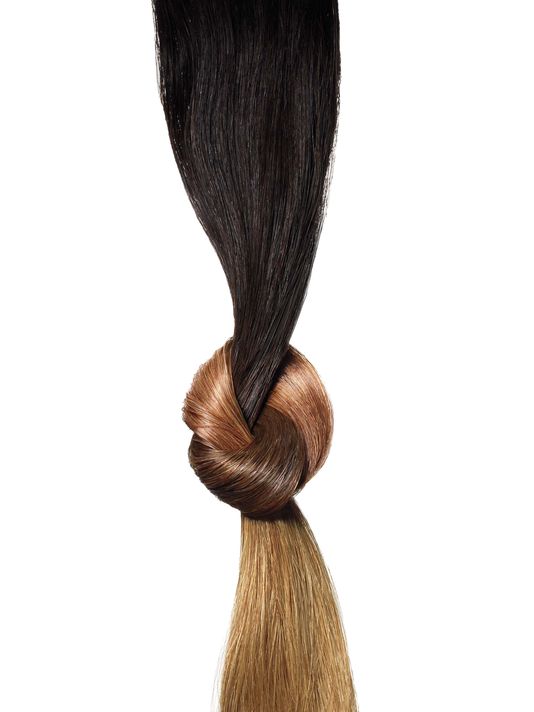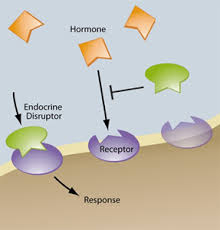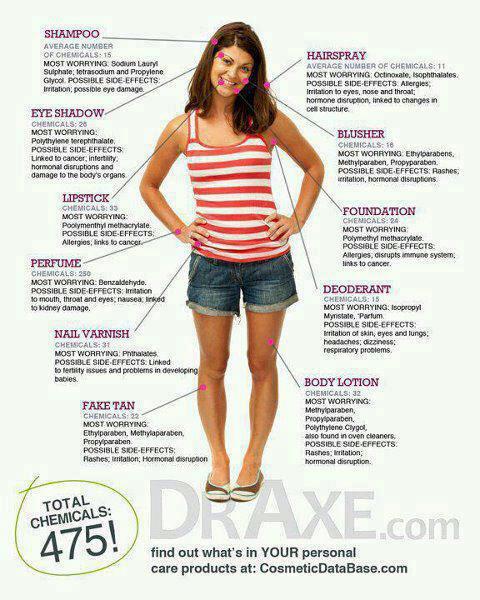If it's one thing our team knows, understands, and stands in empathy for - it would be hair loss. Hair loss can be very complicated to understand. It's a complex concoction of reasons a woman can start loosing hair at any given time in their life. It’s time to debunk those hair loss myths and find out the reality to what causes hair loss and thinning and find out if you are really losing your hair!
Myth 1: If your hair is thinning, it’s because of your mother’s side of the family.
-
Reality: Actually, scientific research proves that hair thinning can occur from mom or dad’s side of the family. Take a look at your immediate family’s hair. If they are losing their hair, you may likely do the same.
Myth 2: Only men suffer from hereditary hair loss.
-
Reality: Ladies, sorry to break it to you but this is false! Women can experience hereditary hair loss just like men. Men tend to lose and thin in concentrated areas, making it more noticeable, but women tend to experience loss and thinning on their entire head.
Myth 3: Women lose their hair after pregnancy and during and after menopause.
-
Reality: While that’s definitely an accurate piece of information, women can begin to lose their hair in their 20’s and even earlier in some instances.
Myth 4: If you’re stressed, your hair will permanently fall out.
-
Reality: During stressful times, hair may fall out but in most cases it should grow back.
Myth 5: If you’re losing hair, you are experiencing hereditary hair loss.
-
Reality: Did you know that 100+ hairs can fall out daily throughout the hair’s natural “resting” (non-growing) phase? If you’re losing hair constantly and it’s not growing back, then you could be onto something.
Myth 6: Shampooing frequently will make your hair fall out.
-
Reality: Since shampooing removes residues and build-up, hair will actually look fuller. It does not actually cause hair loss.
Myth 7: Chemicals, from coloring your hair, will permanently damage hair and cause loss.
-
Reality: While chemicals can weaken hair and cause breakage, unless the hair follicle has been damaged by chemical treatment, which rarely happens, loss is temporary.
Hopefully you’ve learned a fact or two from these hair loss myths and can help educate others as well. It’s never too late to learn how you can prevent or find the right solution for hair loss.
If you would like to learn more about the right solution for your individual hair loss please email (kassie@kasiaorganicsalon.com) or call me (612.824.7611) to set up a private and personal consultation.
You can also learn more about our multi-therapy solutions HERE!
Learn about the COMMON causes of hair loss HERE!
Set up a consultation HERE!
De-FRIZZ! Get a Keratin Express at a Fraction of the Time and Cost
It’s safe to say that summer is finally here! For some of us that means a season of battling frizzy and unmanageable hair. Don’t worry – our professional team has your back. Our Keratin Express Treatment is LOVED by our frazzled hair friends. In fact, they prefer to treat their hair with this efficient 15 minute add-on process every other color. Infused keratin gives you results for manageable, smoother and easier hair to style. It is great for all types – including colored, over processed, and for that “not quite curly wave.”
Liquid Keratin Infusion:
The hair is built in layers, one of these being your cuticle. The cuticle is made up of 95% keratin and is visible to the eye. The everyday wear and tear, hard water, curling irons, and synthetic products create a compound effect – resulting in dull, frizzy, lifeless hair. Think of damaged hair as Swiss cheese - by applying our keratin treatment the holes are made whole again. Keratin will protect the outside cuticle as well as provide internal structure to the cortex creating strength and a smooth shine.
Protein Deficiency
Those with textured hair automatically have a “keratin deficiency.” Our clients with this hair type see a remarkable transformation as they rehab! The more treatments you have the smoother and straighter your hair will become.
The cuticle will return back to its original state as the treatment washes out, although the hair Is left in much better over-all condition. Continuing to use these treatments will only result in healthier, stronger, smoother hair. Clients experience “the gift of keratin” for up to 2 months! Our keratin services are formaldehyde free and the only OSHA keratin approved service to date.
Get Expressed at a fraction of the time and cost!
Limited Time Special - Through July 1st Receive a Express Smoothing Treatment for $75. When combined with a color, receive this treatment for $69
Sip some Cherry Lemongrass Tea and enjoy our SUPER EXPRESS TREATMENT less than a hour or as a 15 minute add on to any cut or color service.
-
No process time
-
All hair types from very fine and thin hair to thick and unruly!
-
$100 ($20 OFF when added to a color)
-
NO FORMALDEHYDE
-
NO HARMFUL CHEMICALS
-
THIS IS NOT A BRAZILLIAN STRAIGHTENING TREATMENT!!
-
This is healthy for your hair, and in no way harmful!!!
-
Last one-two months depending on how often you wash your hair.
-
Prolongs rich color, tone and shine
Looking for a little more girl-power that is longer lasting? Call and speak with one of our stylist regarding the Keratin Smoothing Treatment that will last as long as 3-5 months.
Schedule@kasiaorganicsalon.com * 612.824.7611
Top 10 Reasons to do Laser Hair Treatment
Top 10 for Laser Therapy for Healthier Hair and Optimal Growth
You know the drill. You get up, take a shower, and watch your hair swirl in the drain. You check your hair out in the mirror and find a little less than you had the day before. Your hairline is receding and youve tried the shampoos and the Rogaine with minimal success. Youve done the hair system thing, but thats just not you. So whats a person to do? Live with hair loss? Maybe not. Here are top ten reasons to try a new laser hair treatment program.
1. The use of low level lasers in the treatment of hair loss is one of the latest technological breakthroughs in hair restoration therapy. This low level laser hair treatment has been used with great success in Europe for the past ten years, but is only recently coming into use here in the states. Use of hand-held laser combs have been approved by the FDA for home use.
2. Low light lasers use cool red light to stimulate blood flow up to 54% better to the hair folicle. There are many factors involved in male and female pattern hair loss - genetics, hormones, age. When hair follicles begin to fail because of an overabundance of DHT (dihydrotestosterone) in the body (a hormone that comes with aging) and lack of blood flow to that area of the scalp, hair follicles shrink and eventually miniaturize and fail to thrive. Finally, hair follicles disappear altogether. Once follicles die, nothing can be done to help them. Thats why its important to start laser hair treatment when your hair is in the thinning stage, before its gone altogether. Cool laser hair treatment stimulates this blood flow and restores vitality to the root, encouraging regrowth.
3. Laser hair treatment can be used in conjunction with your current mode of hair loss treatment. If youve taking Rogaine or Propecia and seeing minimal results, laser hair treatment can boost the effectiveness of medications. By stimulating regrowth of hair follicles with the use of red, low light lasers, it helps the medications work more effectively. In clinical studies, 45% of patients saw noticeable results in 6 - 8 weeks, and within 4 - 6 months, another 45% saw definite improvement in the quality of the hair that was regrowing and in the thickness of their hair. For best results talk to a hair loss consultant for a free hair loss consultation, which are normally free
4. Laser hair treatment is pain-free and has virtually no side effects. For those fearful or reluctant to use drugs and prescription medication treatments such as Rogaine or Propecia, a laser hair treatment program offers a safe, effective and risk-free way to treat hair loss. Lasers stimulate blood flow to the scalp, and energized the hair follicles, but do not damage skin. 5. Laser hair treatment will not bust your budget. Compared to other hair loss treatments, laser hair treatments are affordable; the cost is much cheaper than alternatives like surgical hair restoration, or a high-end hair system that will require maintenance.
6. Laser hair treatment vs. hair systems Hair systems require some kind of glue or adhesive to stay on. There is always the risk that an edge will come up or that even the best hair system will be detectable. With laser hair treatment, youre only dealing with your own natural hair. No glue, no hoping people dont notice youre wearing a hair system.
7. No surgery There is no surgery involved with laser hair treatment, and more importantly, no anesthesia required. Hair restoration surgery (or follicular hair transplantation surgery) is very expensive and requires 10 days of downtime following surgery. Laser hair treatments can be done on your lunch break or in front of the TV at night and require no down time. And there is no risk of infection involved as there is with any surgery.
8. Laser Hair Treatments are natural Many people simply dont believe in taking medication or in doing surgery to restore hair. They want a more natural approach. Nothing is more natural than using light to regrow your hair. The kind of red light used in laser hair treatments is not the kind that will give you sunburn or encourage skin problems. On the contrary, it can even help flaky, itchy scalps to heal and naturally stimulate the health and vitality of the scalp and hair.
9. No need to be self-conscious by visiting a hair replacement clinic. If you dread the idea of walking into a hair restoration clinic to be measured, prodded and evaluated, or if you're simply too shy to be bothered with it, a laser hair treatment program with an in-home hand-held laser comb may be your best solution.
10. Hand-held laser combs for home use - If you choose the hand-held laser comb that is now on the market, it's an even more cost effective option. Use of the laser comb two-three times a week at home for 10 to 15 minutes is all you need to do. No need to drive in to a clinic for laser hair treatments. And it's yours forever. As your hair regrows after using laser hair therapy, your confidence will grow as well. A thick head of healthy hair means a more vital, healthy, happy you.
Resource: http://www.hlcconline.com/top-10-reasons-for-laser-hair-growth-treatment.html
Getting Started: Hormone Balance and Hair Health
It's estimated that hair loss affects 1 in 5 women. The most common types of hair loss are telogen effluvium and alopecia areata. Although it's more common than alopecia areata, telogen effluvium is less severe. This occurs when the hair follicles stop growing and lie dormant and fall out within two to three months. Being that telogen effluvium is oftentimes caused by stress, trauma or medications, hair growth is typically restored within 6 to 9 months.
On the flip side, alopecia areata occurs when white blood cells attack hair follicles, causing the hair to thin and fall out, usually in patches. This type of hair loss may require treatment as hair may not grow back on its own.
Your hair says a lot about your overall health. When the body goes into crisis mode, hair growth is stunted to redirect energy to other cells throughout the body . So hair loss is oftentimes the first sign of trouble. While age is definitely a factor of hair loss, other factors, such as hormonal imbalance, emotional stress, medications and hair care products can also lead to thinning of the hair and even male pattern baldness. The best way to get to the root of the problem is to determine the underlying cause.
Hormonal Imbalance and Hair Loss
Hair loss in women is largely attributed to hormonal imbalance. Heard of DHT? Hair loss is not as prevalent in women because women have more estrogen than men and that in turn helps balance out the effects of androgens, namely dihydrotestosterone (DHT), that typically lead to female hair loss. Leading hormonal imbalances such as thyroid problems and excess xenoestrogen conditions can also cause thinning of the hair and premature balding in women.
Emotional Stress and Hair Loss
Although women don't have nearly as much testosterone as men, when women undergo intense stress, the adrenal glands become overworked due to an increased need for the "stress hormone" known as cortisol. This causes the body to produce more adrenaline and testosterone, and DHT, a stronger variant of testosterone. The increased production of these hormones can sometimes cause the hair to fall out due to the resulting hormone imbalance.
Hair Loss after Pregnancy
It's common for women to experience hair loss following pregnancy, when her hormones are in disarray. It takes some time for hormone levels to return to a normal range, so it's perfectly common for post-partum mothers to experience thinning of the hair and even bald patches. In cases such as these, the hair loss is only temporary and treatment oftentimes isn't necessary. Following pregnancy, women can expect hair to re-grow naturally after a few months. If the hair doesn't grow back within the first year, chances are something else is going on.
Hair Loss and The Pill
A variety of medications can result in hair loss in women. Perhaps the most common is birth control. Currently the millions of women use the pill each year, making it the most popular form of birth control to date. When using birth control, women should consider using a low-androgen index birth control pill to avoid the effects of DHT, especially women with a predisposition to hair loss. Research has added that women should exercise caution with any hormonal medication or therapy, as they can all trigger hair loss.
Products, Hair Care and Hair Loss
Do you know which chemicals are in the lotions, shampoos, conditioners, sunscreen and makeup that you put on everyday? It may surprise you to look them up and see the potentially harmful chemicals that companies put into these products.
The chemicals found in everyday house hold products contain carcinogens, reproductive toxicants, as well as substances that can cause allergies and immune problems. I highly recommend a review of the products you use daily for yourself and your family
If you're experiencing hair loss as result of hair care, your first order of business is to ditch the chemical laden products that are damaging your hair. This included hair coloring with conventional ammonia based color. Watch out for other hiding chemicals in hair color such as PPD, MEA, resorcinol, and hydrogen peroxide.
While your hair may look good now, women should consider the potential damage they're doing to their hair. Repetition can damage the hair follicles, but also cause irritation of the scalp.
The Solution: Treating Hair Loss in Women
If you're suffering from hair loss, chances are a hormonal imbalance is to blame. To get started on testing your female hormones, you should look towards estrogen, testosterone (Free T3/T4), thyroid hormones and cortisol to determine if your hair loss is hormonal or genetic.
If a hormonal imbalance is the culprit, our team and company offers professional grade supplements to start your hormonal harmony journey, as well as give you referrals to our thoroughly vetted and trusted medical professional partnerships well versed and able to prescribe bioidentical hormones made by a compounding pharmacy to help you bring your hormone levels back to optimal balance and effectively treat hormonal hair loss in women.
As women, we may not be able to fight your genes, but we can be empowered to fight the effects of aging and hormonal imbalances.
Our passion is to prevent any further hair loss, but to restore hair that you've already lost. Let us help you give your hair what it needs to grow strong and healthy - we are your partner and advocate in this journey that over 50% of women experience.
Enzyme Developer: Upgrade your hair color from hydrogen peroxide!
Stemming in nature, rooted in science
Your hair color just got upgraded.
Nature’s solution to harsh peroxide-based color services of yester - year.

OUR COLOR DIVORCE AND HOW WE HEALED....
The Divorce:
We’ve cut bait. Our team now combines our incredible Zero Ammonia/PPD/Recorcinal and MEA color with Enzyme developers, rather than Hydrogen Peroxide due to the potential damaging effects for vulnerable hair and scalp health.
Why We Did It: HARMFUL CHEMICALS AND SIDE EFFECTS
Hair color is made up of two components: color and developer. The developer contains hydrogen peroxide and ammonia to modify the molecular structure of the hair shaft, allowing large color molecules to penetrate while phenylenediamine (PPD) allows the color to bond with the hair. It is now known that some permanent hair dyes may also contain coal tar, a potentially detrimental petrochemical, and toxic metals such as lead or mercury as developers.
Researchers at The University of California discovered that individuals coloring their hair with permanent dyes once a month for a year or more have twice the risk of developing bladder cancer. Hairdressers or barbers in contact with hair dyes had five times the risk. We are against fear mongering, but we fully are dedicated to knowledge and better choices.
What’s Next: Our New Love!
We’ve seen incredible results with our recent switch. Enzyme developers are naturally formed proteins that neutralize the hair and leave it in superior condition. Continued use of this product, combined with our naturally zero ammonia color and home care products, will restore your hair to its original shine and luster.
You probably have a lot of questions: What is it? What does it do? Well, up until now, your traditional developer used hydrogen peroxide. Hydrogen peroxide swells the cuticles of the hair until it bursts leaving visible and unwanted hair damage.

Enzyme Results:
-
Natural
-
Ammonia Free
-
Complete Color
-
No Peroxide
-
All natural Plant Enzymes
-
PH Balancing
Enzyme developer can do everything peroxide developers can do, plus more!
Here are the friends-with-benefits that lead to our split:
-
Enzymes are a safer and more controlled way of inserting the dye into the hair shaft
-
Instead of creating the damage in depositing and or lifting color, your hair is left healthy, shiny and silky
-
Safe and mild for overall scalp health

-
Color will be brighter and rich to it’s true tone. NO OXIDATION = NO FADING!
-
Takes less time
-
Allergy Friendly
Why doesn’t every salon divorce hydrogen peroxide?
It’s all about the money, honey! Our ethos is to keep you and your follicles healthy. That’s how we get real results. Yes, this does raise our overall costs for color a smidge, but aligned with our mission and big picture view of health and beauty - it’s worth it! We hope you see it this way, too.
All color pricing will increase by $3. Please speak with your stylist with any questions or concerns.
If you prefer to use hydrogen peroxide, please let your stylist know and we will revert back to old systems for your needs.
Contact us today! 612.824.7611
Spring Kidney Cleansing Smoothie and Juice Recipes!
Hello Informed Beauty - I truly believe the winter curse has broken! It's perfect time to hit the reset button in our internal + external beauty regime. Check out these GREAT SMOOTHIES that help to clear and support your oh-so-important kidneys.
Being that our kidneys are an important detoxification organ, it’s important that we learn to nourish them with the right foods. There are many beneficial herbs and foods we can include to support kidney health, and what better way to cleanse and support our kidneys than by juicing!
Here are 6 simple and delicious juice recipes that will help support the health of your kidneys and provide mild diuretic properties to help flush the kidneys of unwanted wastes.
Let’s get juicing…
Watermelon Flush
-
4 cups fresh watermelon, roughly chopped
-
Handful of fresh basil leaves
*Note: This recipes works well in a juicer or blender.
Parsley Purifier
-
½ cup fresh parsley
-
2 celery ribs
-
1 carrot
-
1 cucumber
Dandy-love
-
3 dandelion leaves
-
1/2 green apple
-
2 celery stalks
-
1/2 lemon
-
Chunk of broccoli stalk
Radiant-Radish

-
2 cups radishes, chopped
-
1 celery rib
-
1 cucumber
-
1/2 lemon
Mean & Green
-
Handful of spinach
-
Handful of kale
-
1/2 green apple
-
1/2 lemon
-
1-inch piece fresh ginger
-
½ cup fresh parsley
Cruciferous Goodness
-
1/2 head red cabbage
-
1/2 lemon
-
1 cucumber
-
Chunk of broccoli stalk
-
¼ cup fresh cilantro
All these recipes can be pressed through your juicer and enjoyed any time of day to cleanse and rejuvenate your kidneys and support overall health.
Thank you Guest Post: Young and Raw - http://www.youngandraw.com/6-kidney-cleansing-juice-recipes/
Is your hair thinning? Thyroid Function - look no further!
Our team views our guests multi-dimensionally. Through the focal point of functional medicine and beauty - Justin (guest post) brings light to how your thyroid may be the first place to look if you are experiencing hair loss.
Below are only a few symptoms of low thyroid function (hypothyroidism):
-
Thinning hair (most common)
-
Fatigue
-
Weight gain
-
Constipation
-
Depression
Thinning hair or hair loss is a hallmark sign for low thyroid function.
The hair follicle requires thyroid hormone to produce hair. As thyroid function begins to lower due to stress or an autoimmune condition, it’s possible to see negative changes in your hair quality and or amount. It’s also possible to see hair come off in clumps from your scalp or just see a thinning of the outer third of your eye brows.
Auto-immune hypothyroid patients (Hashimotos) are known to suffer from alopecia or hair loss (1, 2). There is a higher chance of having allopecia or hair loss if you have a hypothyroid condition.
The systemic inflammation underlying most thyroid conditions can be a driving factor of hair loss by decreasing thyroid hormone. Chronic stress will cause in increase in Reverse T3 which has an effect of decreasing active thyroid hormone at the receptor site level. Reverse T3 can also decrease thyroid conversion from T4 (Inactive) to T3 (Active) (3).
Reverse t3 appeared to inhibit the conversion of t4 to T3 with a potency which is about 100 times more than propylthiouracil (4).
Reverse T3 has also been show to to be an excellent indicator for thyroid function even though it’s ignore by most mainstream endocrinologists.
This study demonstrates that rT3 inversely correlates with physical performance scores and that the T3/rT3 ratio is currently the best indicator of tissue levels of thyroid (5).
It’s important if you are suffering from hair loss that you receive a full thyroid panel (not just TSH and T4) including thyroid antibodies, free and total fractions of T4/T3, reverse T3, and T3 uptake.
Having a complete lab panel will allow your Functional Medicine Doctor more information to assess your overall thyroid function and provide a plan that will provide a lasting solution.
Do You Have An Autoimmune Thyroid? Over 5% of the population has an autoimmune thyroid disorder and conventional medicine is ill equipped to address it.
Did you know most mainstream MD’s don’t measure thyroid antibodies? The reason is, it doesn’t change the medication they would put you on in the first place. Being a holistic physician, knowing a patient has an auto-immune thyroid disease can make all the difference in the world in helping the patient get better.
What You Can Do To Assess Thyroid Function Measuring body temperature is an excellent indicator of thyroid function. It can help assess your thyroid function without lab testing and can be an early indicator that you may have a thyroid problem. I always recommend combining thyroid temperature testing along with a comprehensive thyroid lab panel.
What If My Thyroid Tests Are Normal?
Most patients never get a comprehensive thyroid test to being with. When the are told they are normal it’s usually their Doctor letting them know their TSH is out of the pathological range >4.5. Below is an example of lab work looks to most Doctors.
It’s important to note that 95% of the population comprise the so called “Normal” range. Just go look around and you’ll be hard pressed to find 95% of people you know with normal health. As the population gets sicker, the references get wider, decreasing the chance of conventional labs picking up on your thyroid condition.
Functional Medicine Doctors look at thyroid tests on a functional spectrum of thyroid health. This allows more patient’s with thyroid issues to be detected and not slip through the cracks like they would in the conventional medical world.
It’s possible to have a normal thyroid blood test and still have a low body temperature. It’s always best to look at both temperature, thyroid function and adrenal functional when addressing harder thyroid cases.
Adequate body temperature ranges between: -97.8-98.2 degrees for the axillary area (armpit). -98.2-98.6 degrees for the oral area (mouth).
Healthy thyroid temperature shouldn’t vary more than 0.3 degrees per day. If you see a variance of great than 0.3 degrees per day, this is a sign of adrenal stress. Adrenal fatigue can also contribute to thyroid dysfunction.
Some individuals may need small amounts of natural thyroid hormone to jump start their system, others may need a more comprehensive approach that looks at addressing the adrenal glands and the nutrients required for healthy T4 to T3 conversion. Either way I strongly urge anyone in this situation to get a comprehensive assessment to figure out which approach is best.
From a functional medicine paradigm it’s important to know if you are auto-immune because it changes the overall approach to how the thyroid is treated. Any time any auto-immune condition is present the focus needs to more on the immune system and the gut and less on the thyroid or injured gland.
Most Important Lab Tests
TSH: Pituitary hormones that signals the thyroid to make T4, a poor marker of thyroid status unless elevated. Total T4: 98% of T4 thyroid hormone that is inactive and protein bound. Free T4: 2% of T4 thyroid hormone that is active and freely bound. Total T3: 98% of T3 thyroid hormone that is inactive and protein bound. Free T3: 2% of T3 thyroid hormone that is active and freely bound. Reverse T3: Sign of a stressed physiology and a slower metabolism. Thyroglobulin: Increases with BCP’s (birth control pills) and higher levels of estrogen, decreases with elevation in testosterone like in PCOS. T3 Uptake: How much active thyroid hormone is taken up by the receptor site. Elevated upate can be a sign of higher levels of testosterone commonly cause by PCOS (Poly Cystic Ovarian Syndrome) in females. Low uptake can be caused by elevations in estrogen primarily seen by BCP’s. TPO Antibody: 70% of auto-immune patients are positive for TPO. TBG Antibody: Less likely positive but should still be tested to rule out auto-immunity. TSI Antibody/Thyrotropin receptor antibodies: Auto-immune condition that causes hyperthyroidism or Graves Disease.
Thank you - Guest Post: Dr. Justin Marchegiani
Learn more about your thyroid, immunity, and getting to the root - here!
















